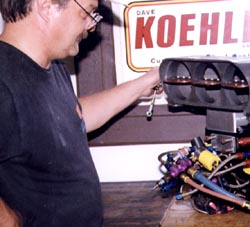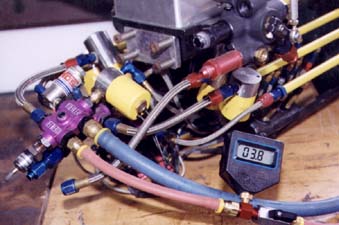Open Flow Testing
Or Why the villagers scurry when the dam breaks!
by Dave Koehler
 Sooner or later, a nitrous user will come across this phrase in reference
to tuning his nitrous system. It is exotic sounding and usually spoken
in a voice that makes it sound like some big secret nitrous incantation.
Blue Magic, maybe? For nitrous newbies this conjures
up visions of test benches costing thousands of dollars. Fortunately
open flow testing is a little more down to earth and requires some basic
high school math and a financial investment costing less than a single
nitrous bottle. Sooner or later, a nitrous user will come across this phrase in reference
to tuning his nitrous system. It is exotic sounding and usually spoken
in a voice that makes it sound like some big secret nitrous incantation.
Blue Magic, maybe? For nitrous newbies this conjures
up visions of test benches costing thousands of dollars. Fortunately
open flow testing is a little more down to earth and requires some basic
high school math and a financial investment costing less than a single
nitrous bottle.
Open Flow Testing is the act of simulating the fuel
flow pressure with the nitrous system on but without filling the engine
up with fuel with the engine off.
Now, the word flowing gets tossed around a lot because
that is what somebody called it years ago and it just stuck. While fuel
is indeed "flowing" what we are really simulating is the pressure
on the output side of the solenoid when the nitrous system is activated.
Here in the shop we can measure actual fuel flow with high dollar sensors
which is even more accurate but this is not always possible or easy
to do in the field.
Why is this open pressure important? When the solenoid
opens there will ALWAYS be a pressure drop. How much is dictated by
the size of the pump , type of regulator used and the jet/plate/nozzles
that are trying to be filled.
Picture the movie with the dam breaking. All that water
built up behind the dam creates pressure on the dam. The dam breaks
and the water runs down the valley sending the villagers scurrying.
Now, all of a sudden there is a whole lot of flow going on at the dam
but the pressure built up behind the dam is significantly reduced or
gone and the down stream pressure is a best guess. This is what we need
to know. What is the flow pressure in the valley now that the dam has
burst? Once we know what this pressure is or is not we can make fuel
delivery system changes to ensure that the desired fuel pressure is
present when the nitrous system is activated.
When you buy a nitrous kit you normally get an instruction
sheet that states what fuel pressure is desired with the nitrous system.
What is sometimes not clear in the instructions is that this pressure
is to be with the system ON. What the pressure is with the system OFF
is unimportant in most cases.
Well, ok. How do we know what the pressure is without
burning up or flooding out the engine? Open flow testing works on any
plate or nozzle based system, street or strip, and you can do single
or multiple stages. Testing will allow you to confidently dial in your
systems according to the information supplied by the nitrous manufacturers
or your nitrous guru. Once you have a baseline you can go back and make
those small changes with confidence at home or at the track. This testing
can also help pinpoint a fuel pump or regulator problem. The beauty
of all this is it is done with the engine OFF. There is no need to wear
the car out trying to guess at the running pressure.
Follow along as I break this down this great mystery.
"Open" refers to the fuel solenoid being turned on and fuel
"flowing" through it. This is what we are going to "test".
 A
good commercial open flow test tool consists of an on/off mechanical
valve to simulate the solenoid opening and closing, a pressure gauge
capable of reading in tenths of a pound, a jet holding fixture, along
with associated hoses, instructions, etc. A
good commercial open flow test tool consists of an on/off mechanical
valve to simulate the solenoid opening and closing, a pressure gauge
capable of reading in tenths of a pound, a jet holding fixture, along
with associated hoses, instructions, etc.
Ok, let's get down to work and set up the test. First,
do not be foolish. You will be working with a flammable fuel. Use all
the safety precautions you ever learned or heard of when doing this
test. Note that we are only testing the fuel side. Disconnect the fuel
line from your regulator to the fuel solenoid and connect the input
hose of the tester to this port on the regulator. This is normally a
# 6 line. Put the output hose of the tester in the fuel tank or bucket.
The next step is to choose a jet for the test. If you have a single
plate this is simple. The flow test jet will be the same size as the
jet in the plate. IE: .082 fuel jet =. 082 flow jet.
It gets more interesting with dual plates, multiple
stages or foggers. I will explain a nozzle system with eight nozzles.
The same math will work for 2 plates (jets), or whatever amount of jets
you have a figure.
Note that some simpler commercial kits use carburetor
jets for the flow jet. I do not agree with this as it confuses the racer/tuner
since the carb jet numbers do not match up to the actual diameter of
the hole. The other reason I use a special made jet is that if you are
testing a large or multiple stage system there is not a carb jet large
enough to simulate the flow. I will be discussing flow jets with flow
numbers that match the diameter of the hole.
Class time. You will need
your calculator.
To figure the flow jet size for multiple jets do the
following math:
Diam. X Diam. X 0.7854 X N= Flow
test jet area
Where N is the number of jets (i.e. 8 foggers)
and Diam. is the inside diameter of the fuel jets.
As an example we will compute 8.032 nozzle jets:
0.032 X 0.032 X 0.7854 X 8 =
0.0064366 total area
Now that we have the total area we need to compute what
diameter flow jet the total area equals. And it goes like this:
Flow Jet Diameter = SqRt (AREA
/ .7854)
0.0064366 / 0.7854 = 0.0081953
SqRt (0.0081953) (just
hit the square root key) = 0.0905278
Rounded off = 0.091 flow jet
Pretty neat, huh? Now that we have the flow jet installed
we can test. With the on/off valve closed and the output hose in the
tank or bucket, turn on the gauge and zero it. Turn on the nitrous fuel
pump and note the pressure reading. Open the on/off valve and note your
open flow reading. Lot of fuel going through there isn't it? If not,
the open flow test kit just paid for itself!! If the pressure is not
where it's supposed to be adjust the regulator accordingly.
Here is where it makes nitrous more fun. Less work at
the track!! Take all the jets you tune with and do the same test with
all of them. You should be able to map what changes have to be made
according to what jet to use. Take your black book to the track with
this information and save a bunch of hurry up work at the track.
|

